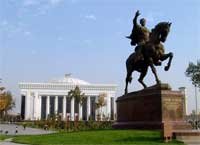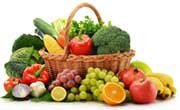March 24, 2014
Number of population employed in Uzbek economy was 12.523 million.. 2
Retail trade turnover of Uzbekistan reaches 47.464 trillion soums. 2
Uzbekistan approves logo ‘Health Food’2
Old Tire to Live a Second Life. 4
Press-service of MFA of the Republic of Uzbekistan
economy
Number of population employed in Uzbek economy was 12.523 million
In January-December 2013, according to the preliminary data, the number of population employed in the economy of Uzbekistan was 12.523 million and increased by 2.5% in comparison with January- December 2012.
State Statistics Committee of Uzbekistan said that the significant growth in the number of employed persons is marked in trade, catering, sales and procurement (by 3.7%), housing and utilities and non-productive personal services (by 3.6%), construction (by 3.5%), transport and communication (by 3.5%), agriculture and forestry (by 3.3%).
As a whole the share of persons employed in the non-state sector has reached 81.2% versus 80.7% in January-December 2012.
The number of citizens registered through labor agencies as those who are looking for a job was 5,400 persons as of the end of December 2013 versus 6,000 persons as of the end of December 2012.
In January-December 2013, the number of the unemployed defined in compliance with the method for calculation of unoccupied population which requires employment, approved by the Resolution of the Goverment of the Republic of Uzbekistan from 24 May 2007, No. 106, was 639,700 persons, the rate of unemployment – 4,9% of economically active population.
The high rate of unemployment in comparison with the republic one is observed in the Republic of Karakalpakstan (the number of unemployed persons – 40,300, the rate of unemployment – 6.2% of economically active population), Andijan region (68,500 and 5.4%), Samarkand region (76,200 and 5.3%), Khorezm region (37,100 and 5.3%), Kashkadarya region (58,300 and 5.2%), Namangan region (49,600 persons and 5.2%), Surkhndarya region (47,600 and 5.2%), Navoi region (22,800 and 5.2%).
(Source: Uzdaily.com)
Retail trade turnover of Uzbekistan reaches 47.464 trillion soums
In January-December 2013, the retail trade turnover of Uzbekistan reached 47.464 trillion soums or grew by 14.8% compared to 2012, the State Statistics Committee of Uzbekistan said.
In the structure of retail trade turnover the share of food products was 51.2% and that of non-food products – 48.8% (in January-December 2012 – 49.2% and 50.8% respectively).
In January-December 2013, the retail trade turnover of trade enterprises amounted to 18.125 trillion soums or increased by 17.5% in comparison with January-December 2012. In the structure of the retail trade the share of turnover of trade enterprises was 38.2%.
In the total turnover of trade enterprises the share of the retail trade turnover of trade enterprises in the rural area was 22.3%.
The sale of agricultural products and livestock in dekhkan markets has increased by 11.4% and reached 19.183 trillion soums, the share of sales in the retail trade turnover was 40,4%.
The goods turnover of commodity and specialized markets was 10.155 trillion soums or 16.6% higher than in January-December 2012. The share of the informal sector in the total volume of goods turnover was 21.4%.
(Source: Uzdaily.com)
Society
Uzbekistan approves logo ‘Health Food’
The Ministry of Health of Uzbekistan and the Uzstandart Agency are to approve a special logo ‘Health Food’ for food labeling. Uzbekistan Today correspondent talked to the head of the Laboratory of N utrition Hygiene of the Research Institute of Hygiene, Sanitation and Occupational Diseases, Olga Elinskaya.
-Our health depends on the quality of food as well. Who controls the quality of products?
Speaking of industrial products, then all it is certified. This means they are verified by the Ministry of Health for compliance with health and safety standards and the Uzstandart Agency’s standards conformity. Quality of products for sale is checked by the service of sanitary-veterinary supervision of the Ministry of Agriculture and Water Resources. In this case not only their quality, but also the conditions of their sales are controlled. I want to emphasize the country has a rather effective system of quality control of food products.
-How often do these standards get revised? Indeed, the food industry is constantly offering new products.
This work is done permanently. And standards are revised as necessary. For example, the existing rules have only a list of food additives permitted for use. Our laboratory develops a new document in which the use of each food additive is strictly regulated. This need has arisen due to expansion of the list of additives, and information about them. Some of them change their properties during the process and can be hazardous to health.
Technical documentation is getting developed of new products, production of which will be carried out industrially. For example, a recently packed norin has appeared on stalls of supermarkets. Its producers have had to develop a complete documentation package to this dish. In particular, the requirements have been specified for products used in its manufacture, production technology, storage regulations, and shelf life.
-New information gets appeared periodically about the product, which is known and used since long time. Forexample, of late doctors warn about the dangers of trans fats contained in margarine, salt and sugar. What do think our experts about this?
-We should follow the norms and rules in the consumption of these products and then health would not suffer. Unfortunately, today our food has excess of salt and sugar, the rules of cooking with margarine and spreads get violated. Now the country begins extensive work to improve the current regulatory documents and control system. Current regulations will be revised in accordance with the new recommendations of the World Health Organization. Simultaneously, the work will be done on the harmonization of the existing methods for determining the content of salt, sugar and trans fats in food products with international standards.
–What about the products produced using genetically modified organisms?
-It’s no secret that the world has such products. Uzbekistan is an integral part of the global market. It is barely possible to avoid keeping them out of our domestic market. Their quality is controlled in accordance with established rules and regulations. Laboratories fitted up with necessary equipment to control GMO products work in Uzbekistan as well.
Now, Uzbekistan’s scholars are starting to establish the scientific-practical basis to provide the growing generation with safe food produced using GMO. It is intended to develop hygienic security regulations to prevent risks associated with public health.
Another issue is that the world has no data on long-term results of eating GMO food. Therefore, we should tаkе it a rule to read what is written on the label of the product. If the list contains the ingredients you do not trust, it is better not to purchase the product.
–The excess of some elements in food and lack of the others could be harmful to health. Are there conducted any studies to balance nutrition?
Results of recent studies we learn in the coming months. Currently, a group of experts of the Uzstandart Agency and the Ministry of Health gets engaged in assessing the diet, including the level of nutrients, sugar, fiber, saturated fat and salt. Insufficient and excess nutrition requires extensive studies, as well as pollution problems and products tampering. Nutrition balance should be assessed in complex. For example, todayis obvious that the average citizen of the republic is using a lot of fat and cholesterol at insufficiency of fibers in the diet. Based on the results of these studies we would be able to develop new programs and standards oriented on saturation of the market with healthy foods. Implementation of these programs is an effective tool for health promotion. For example, the implementation of the program on enriching flour with nutrients made possible to reduce the number of women and children suffering from anemia.
-Is there a comprehensive program aimed at improving the nutritional status of the population?
Approval of this kind of program is expected by the end of this year. Today, individual programs are implemented for the prevention of diseases caused by iodine deficiency, iron and other micronutrients, and comprehensive actions plan to promote healthy eating, approved by the chief public health physician. It is obvious that in the near future the work to improve the nutritional status will be conjugated with the introduction of new regulations and new tests of quality control of products that will ensure the safe use of all engineering innovations.
-What will be done to ensure that regulatory documentation would be understandable and accessible to the average consumer?
In the third quarter of this year, the Ministry of Health and the Uzstandart Agency are to approve the logo ‘Health Food.’ This symbol will be used for labeling of goods produced to new standards oriented in production of healthy foods.
In addition, the Republican Center of State Sanitary-Epidemiological Surveillance in conjunction with the Institute of Health and Medical Statistics are to develop and publish reference materials and booklets. Their content will be based on the recommendations of the World Health Organization. Media is to be attracted for extensive information campaign.
(Source: “Uzbekistan Today” newspaper)
ecology
Old Tire to Live a Second Life
During a media tour to the Tashkent Tire Repair Plant, organized by the State Committee for Nature Protection, local journalists got acquainted with the structure of the forefront enterprise, which introduces eco-friendly technologies for processing and production of rubber engineering goods.
The issue of processing waste with its rapidly growing volumes is pressing across the world. An important part is assigned to hardly recyclable toxic waste like second-hand tires. According to different data, the world is annually filled with about 800-900 million of worn-out tires and only 20% of them are used again.
Uzbekistan has several enterprises dealing with their processing using environmentally friendly technologies. Al Said joint venture in Qarshi, Rubber Product in Chirchiq and the Tashkent Tire Repair Plant are engaged in restoration of tires and manufacture of raw rubber and rubber products on their basis – rubber pavers for playgrounds and sports grounds and crumb rubber for soccer fields.
Over the past few years, the Tashkent plant has undergone significant changes: it acquired up-to-date equipment for mechanical waste recycling, launched the production of secondary raw materials and finished goods, introduced advanced technologies. Participants of the media tour visited the production shops and learned about the environmentally friendly tire recycling.
According to deputy general director of the plant Asamjon Hidoyatov, in most cases people burn waste tires, remove them to landfills or simply discard. However, the burning emits noxious poisonous substances, and decomposition of rubber tires varies between 100 and 150 years. Hence, they need to be processed and reused, which undoubtedly has both ecological and economic importance.
Mechanical recycling is an environmentally friendly method of disposal. It results in 65% of crumb rubber, 25% of the metal cord, which is used as a raw material for melting metal products, and 10% of textile fibers. The processing goes without any smoke and unpleasant odors.
As noted by specialists of the plant, the introduction of processing technologies challenges them with building a system of collection of raw materials from the population, businesses and various institutions. The popular demand and the capacities of the enterprise make it possible to process up to 1,500 tons of used tires annually.
The dynamic growth in the car fleet of Uzbekistan conditions the continuous accumulation of waste tires. A part of waste is recycled, the rest clusters on illegal dumps or just on the streets, courtyards, burdening the environmental situation. Therefore, each person can contribute to improving the environment through carrying waste to recycling centers for processing and production of rubber products.
The experience of the Tashkent tire-repair plant clearly suggests the opportunity of producing a variety of useful goods from old tires instead of environmentally harmful incineration or storage.
(Source: “Uzbekistan Today” newspaper)





















